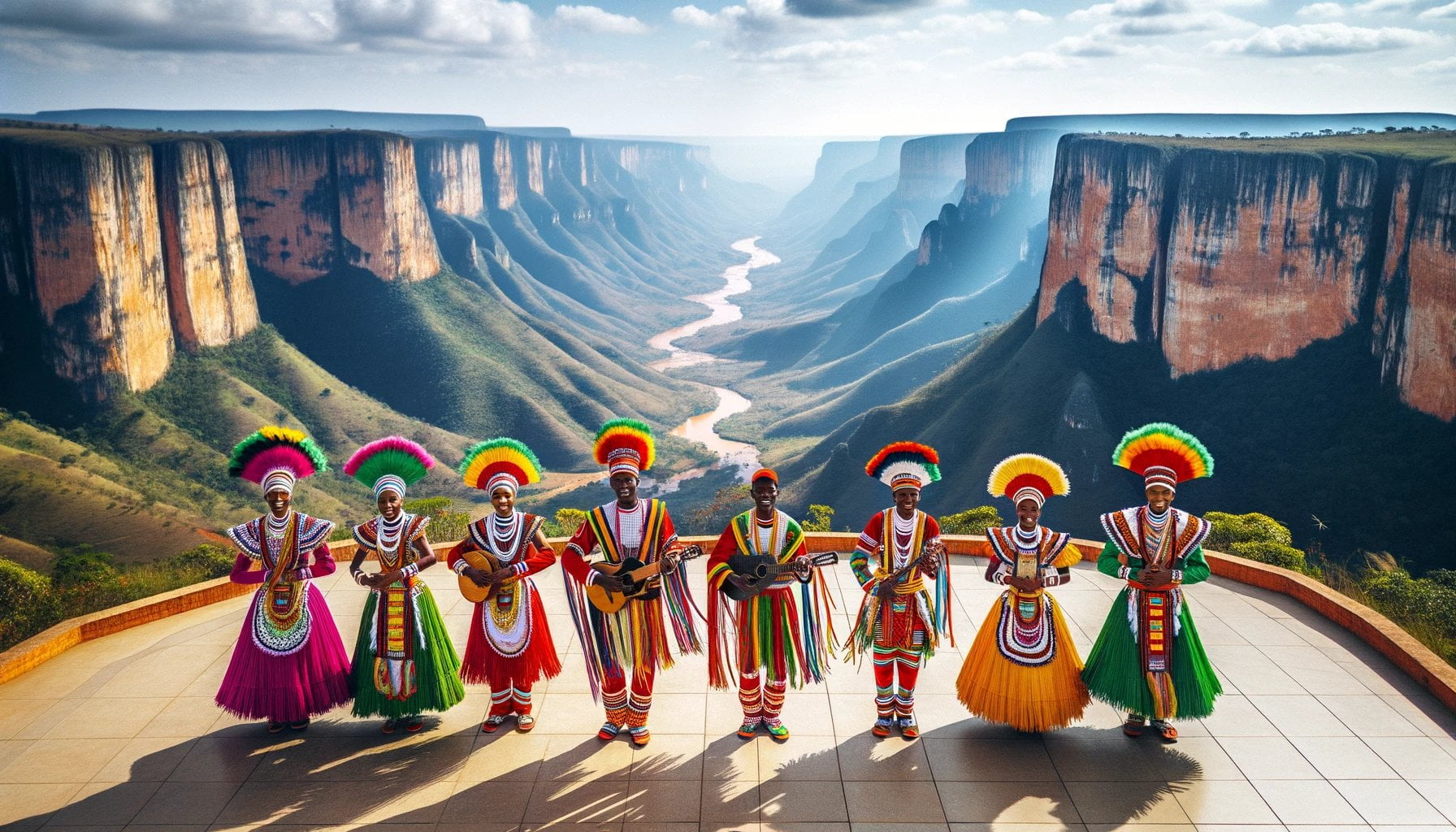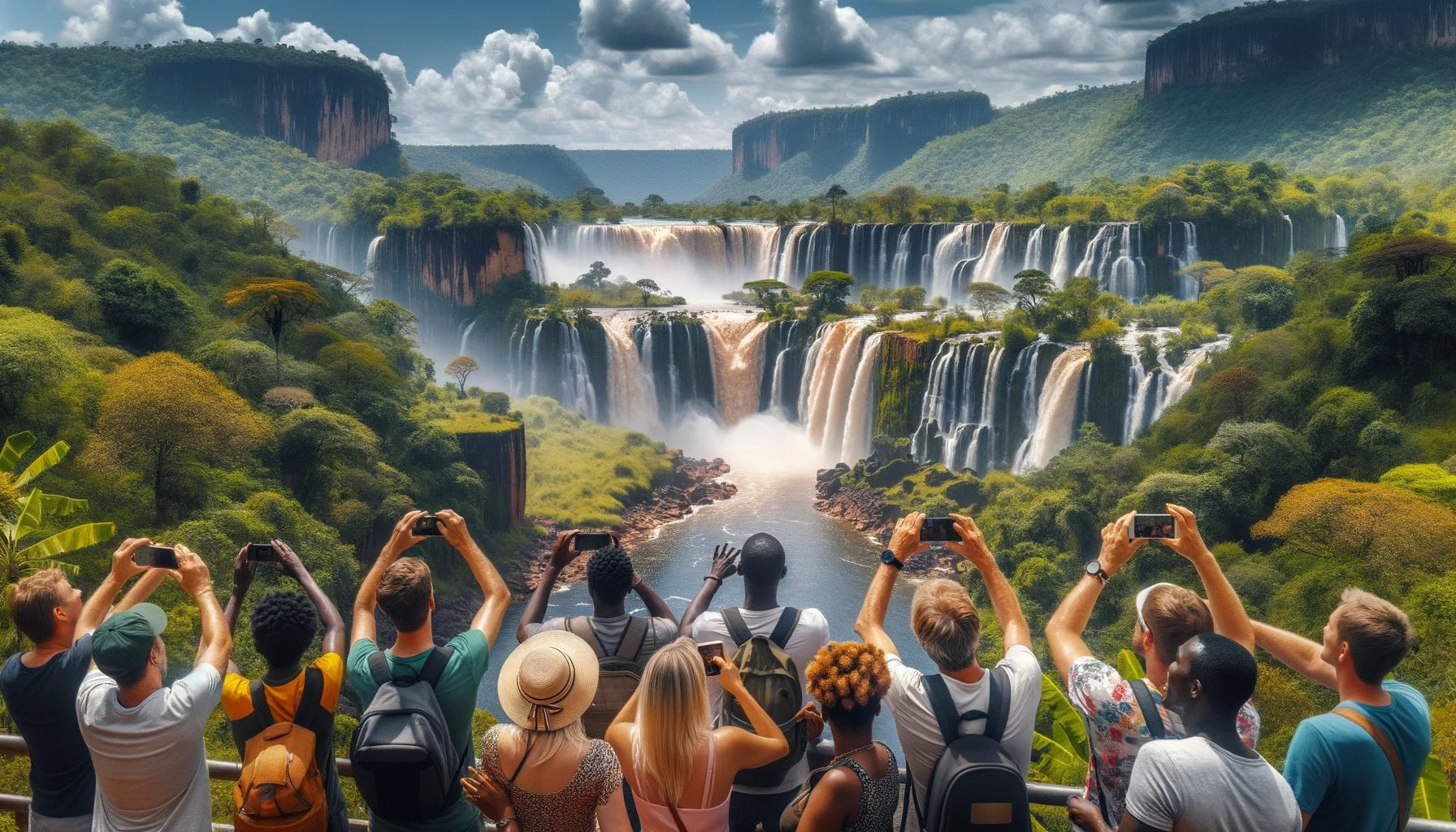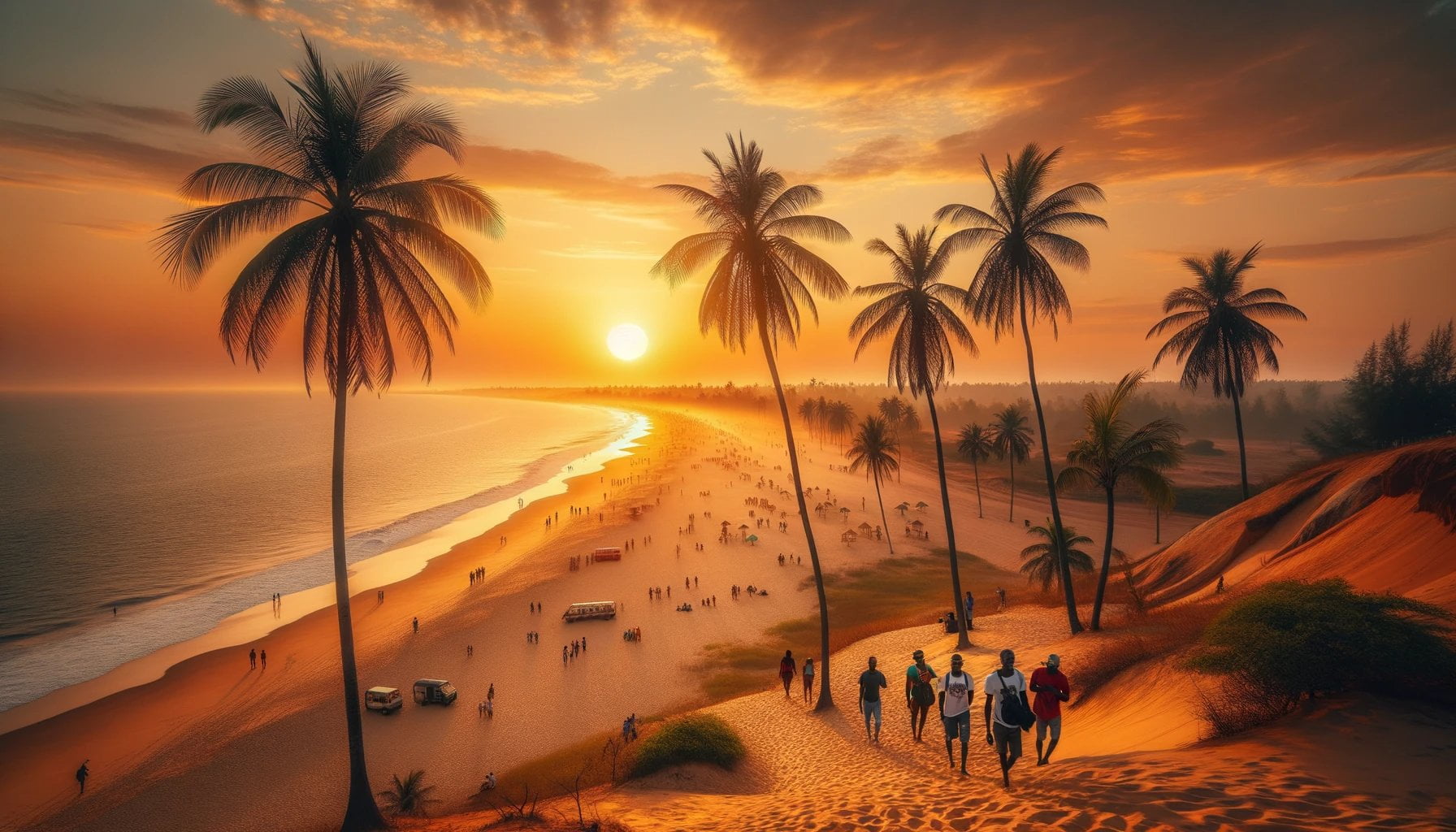Embark on a journey to Angola, a country brimming with awe-inspiring landscapes, rich cultural heritage, and a vast untapped potential as a tourist destination. Nestled on the western coast of Africa, Angola is a hidden gem waiting to be discovered by intrepid travelers. As an emerging hotspot in the world of tourism, this enigmatic land offers an abundance of unique experiences that captivate the senses and ignite the imagination. From its vibrant cities to its unspoiled natural wonders, Angola beckons adventurers to delve into its secrets and unlock its hidden treasures. In this article, we will uncover the unexplored allure of Angola, shedding light on its fascinating stories, breathtaking landscapes, and the endless possibilities that await curious travelers. Get ready to embark on a remarkable journey unlike any other as we open the doors to Angola’s untapped potential.
Key Takeaways:
- Tourism in Angola is based on the country’s natural environment, including rivers, waterfalls, and the coastline.
- Angola’s tourism industry is relatively new due to the impact of the civil war which ended in 2002.
- Cameia National Park in the Moxico province offers seasonally inundated plains, miombo woodlands, and two lakes, known for their aquatic birds.
- Cangandala National Park in the Malanje province is the smallest national park in Angola and is known for its unique flora and rock formations.
- Iona National Park in Namibe Province is the largest national park in Angola and is known for its wildlife, but faces challenges such as illegal poaching and infrastructure destruction.
- Mupa National Park in the Cunene province is a significant birdwatching site, but human settlements within the park threaten its birdlife.
- Angola has a coastline of 1,650 km, providing opportunities for beach tourism and beautiful views of the Atlantic Ocean.
- Additional information on tourism in Angola can be found on the Lonely Planet and The Crazy Tourist websites.
References:
1. Tourism in Angola – Wikipedia
2. 15 Best Places to Visit in Angola – The Crazy Tourist
3. Angola travel – Lonely Planet | Africa
Tourism in Angola

Angola, a country with an untapped potential for tourism, is slowly emerging as an intriguing destination for adventurous travelers looking to discover hidden treasures. With its natural beauty, rich heritage, and vibrant landscapes, Angola offers a unique and authentic experience that sets it apart from other tourist hotspots. In this article, we will delve into the visitor attractions and coastline that make Angola a must-visit destination for avid explorers.
Visitor Attractions
1. Cameia National Park: Located in the Moxico province, Cameia National Park offers a fascinating blend of breathtaking landscapes and diverse wildlife. This national park, situated at about 1100 meters above sea level, boasts seasonally inundated plains, mesmerizing miombo woodlands, and two sparkling lakes, Lago Cameia and Lago Dilolo. One of its highlights is its thriving population of aquatic birds, which make for a captivating sight.
2. Cangandala National Park: Despite being the smallest national park in Angola, Cangandala National Park, nestled in the Malanje province, packs a punch with its unique flora and outstanding rock formations. This park is a nature lover’s paradise, offering an opportunity to explore its enchanting trails and discover the hidden gems within its boundaries.
3. Iona National Park: If you’re a wildlife enthusiast, Iona National Park in Namibe Province is a must-visit. Covering a vast area of 15,200 square kilometers, it is the largest national park in Angola. However, it faces challenges due to illegal poaching and the destruction of infrastructure. Despite these setbacks, Iona National Park still harbors an abundance of wildlife that is sure to leave any nature lover in awe.
4. Mupa National Park: Situated in the southwestern Cunene province, Mupa National Park is a birdwatcher’s paradise. Its diverse avian population and picturesque scenery make it a haven for bird enthusiasts. However, the presence of human settlements within the park poses a threat to its birdlife, making it crucial to raise awareness about preserving this fragile ecosystem.
Coastal Charm
Angola’s coastline stretching 1,650 km along the Atlantic Ocean presents an opportunity for beach tourism and awe-inspiring vistas. From serene sandy stretches to dramatic cliff formations, the coastline offers a diverse and captivating landscape worth exploring. Whether you seek relaxation or adrenaline-fueled water activities, Angola’s coastal charm has something for everyone.
To enhance your understanding of tourism in Angola, you can visit reputable sources like Lonely Planet and The Crazy Tourist. These sources provide detailed information on tourist destinations, attractions, and useful travel tips to make your journey to Angola seamless.
As Angola continues to unveil its hidden treasures, the country’s potential as an emerging tourist destination becomes increasingly evident. Through our exploration of visitor attractions and the allure of its coastline, we hope to inspire you to embark on a remarkable journey to Angola, where adventure and discovery await.
Note: The referenced sources for further information are listed at the end of this article.
References:
[1] Tourism in Angola – Wikipedia
[2] 15 Best Places to Visit in Angola – The Crazy Tourist
[3] Angola travel – Lonely Planet | Africa
If you want to uncover fascinating facts about Angola, don’t miss out on our informative page about facts about Angola. Delve into the rich culture of Angola by exploring our captivating insights on Angola culture. Discover the compelling history of Angola and its remarkable journey through time by clicking on Angola history. Get ready to embark on a virtual journey to the most famous places in Angola by visiting our enticing article on famous places in Angola. Indulge your taste buds with the delectable and unique flavors of Angola’s cuisine by checking out our mouth-watering guide on Angola cuisine.
Exploring Angola’s Cultural Heritage and Traditions
Angola, the southwestern African country, is a hidden gem when it comes to cultural heritage and traditions. Influenced by the traditions of the central Bantu peoples and the ancient kingdom of Kongo, Angola boasts a vibrant and diverse culture that showcases its rich history. Let’s delve into the untapped potential of Angola’s tourism, and embark on a journey of discovery, exploring its captivating cultural heritage and traditions.
Unveiling the Beauty of Angola’s Cultural Heritage
Angola’s cultural heritage is a tapestry woven with music, dance, art, and architecture. The Portuguese colonial influence adds an intriguing layer to the country’s historic buildings and distinctive architectural styles. Travelers can explore these architectural marvels and get a glimpse of the past that shaped Angola’s cultural identity.
In addition to colonial influences, Angola’s cultural heritage is deeply rooted in the traditional music, dance, and cuisine of its people. With rhythmic beats and graceful movements, traditional Angolan dances provide a window into the soul of the nation. Visitors are captivated by the diversity of rhythms and dance styles that reflect the different ethnic groups across the country.
Preserving Angola’s Cultural Treasures
Angola proudly preserves and promotes its cultural heritage through various museums and cultural institutions. These establishments showcase the history, art, and traditions of the country, allowing visitors to delve deeper into Angola’s rich heritage. One prominent example is the Museum of Anthropology, which highlights the diversity of Angola’s ethnic groups, their rituals, and the traditional objects they use.
Furthermore, initiatives led by organizations such as UNESCO aim to safeguard Angola’s cultural heritage by identifying and protecting important sites. The Kwanza River corridor, with its unique natural and cultural landscapes, is a potential candidate for becoming a UNESCO World Heritage Site. This recognition would further open doors to tourists, revealing the hidden treasures of Angola’s cultural heritage.
Immersing Yourself in Angolan Traditions
Angola’s cultural heritage comes alive through vibrant festivals and celebrations. These events showcase the soul and spirit of the Angolan people, allowing visitors to experience the rhythm of the nation. Whether it’s the vibrant colors and energetic dances of the Luanda Carnival, the traditional rituals of the Luvale Tribe, or the captivating music of traditional Angolan genres such as Semba and Kizomba, there is always something to explore and experience.
With its rich cultural heritage and traditions, Angola beckons travelers to immerse themselves in an authentic experience. By interacting with local communities, visitors can gain a deeper understanding of the customs, beliefs, and values that shape Angola’s identity. From learning about traditional handicrafts to participating in local rituals, there are endless opportunities to connect with the heart and soul of this intriguing country.
Key Takeaways:
- Angola’s cultural heritage is influenced by the traditions of the central Bantu peoples and the ancient kingdom of Kongo.
- The country’s vibrant culture is showcased through music, dance, art, and architecture, which reflect both indigenous traditions and Portuguese colonial influences.
- Angola’s cultural heritage is preserved and promoted through museums, cultural institutions, and initiatives led by organizations like UNESCO.
- Festivals and celebrations offer visitors a chance to experience the rich traditions and rhythms of Angola.
- By interacting with local communities, travelers can get a deeper understanding of and appreciation for Angola’s cultural heritage and traditions.
Sources:
– Exploring Angola: A Rich Culture and Complex History
– Angola’s Heritage & Festivals
Untapped potential: Developing tourism infrastructure in Angola
Angola, with its breathtaking interior landscapes, rich fauna, wildlife, and national park system, holds immense untapped potential as a tourist destination. The country boasts a long coastline along the Atlantic Ocean, a vast central plateau, and borders with Namibia, Botswana, Zambia, and the Democratic Republic of the Congo. Despite facing challenges as the second-largest oil producer in Africa, Angola has embarked on an ambitious infrastructure plan driven by regulatory reforms, investor incentives, and public-private partnerships. These efforts aim to unlock economic growth and harness Angola’s hidden treasures for the world to discover.
One of the key focal points for unlocking Angola’s tourism potential lies in developing its tourism infrastructure. By investing in the necessary infrastructure, Angola can create an enabling environment for both local and international visitors to explore its wonders. But what exactly does developing tourism infrastructure entail, and how can Angola enhance its untapped potential? Let’s delve deeper into this topic.
The Power of Connectivity: Improving Transportation and Accessibility
When it comes to tourism, accessibility plays a crucial role. Developing a robust transportation network is essential for unlocking Angola’s hidden gems. The government’s infrastructure plan must prioritize improving roads, airports, and other modes of transportation, ensuring seamless connections between various regions and attractions. By enhancing access to remote areas and tourism hotspots, Angola can open up a world of possibilities for visitors seeking authentic and off-the-beaten-path experiences.
Showcasing Angola’s Natural Splendor: Supporting Sustainable Tourism
Angola’s natural beauty, from its diverse wildlife to its stunning national parks, offers a wealth of experiences. To harness this potential, sustainable tourism practices must be at the forefront of Angola’s infrastructure development. Ensuring responsible management of protected areas, promoting eco-friendly accommodation options, and raising awareness about conservation efforts are key components of sustainable tourism. By safeguarding its natural heritage and promoting responsible travel, Angola can attract conscious travelers seeking unforgettable encounters with nature.
Empowering Local Communities: Fostering Rural Tourism
Angola’s rural communities hold immense potential for tourism development. By leveraging the untapped resources and unique cultural experiences found in these areas, Angola has the opportunity to revitalize communities while providing authentic travel experiences. The tourism infrastructure plan should aim to empower local communities by providing training programs, financial assistance, and support for the development of community-based tourism initiatives. Embracing rural tourism not only boosts local economies but also enables visitors to connect with the heart and soul of Angola, forging meaningful connections and creating lasting memories.
Spotlight on the Creative Industries: Promoting Cultural Tourism
Angola’s creative talents and emerging innovation ecosystems can contribute significantly to the development of the country’s tourism sector. By harnessing the power of the creative industries, Angola can position itself as a hub for cultural tourism. The infrastructure plan should prioritize the promotion and preservation of Angola’s cultural heritage through initiatives like festivals, exhibitions, and cultural institutions. Such efforts will showcase the country’s vibrant music, dance, art, and architecture, providing visitors with a deeper understanding of Angola’s diverse cultural tapestry.
Leveraging Technology: Embracing Digital-Based Tourism
As Angola looks to expand its business activity beyond the capital city of Luanda, embracing digital-based tourism is essential. The infrastructure plan should focus on improving digital connectivity, expanding access to reliable internet services, and supporting the growth of digital platforms that facilitate travel bookings and information sharing. By leveraging technology, Angola can connect with a global audience, attract digital nomads, and provide seamless experiences for travelers seeking to explore the country’s hidden gems.
Key Takeaways:
- Improving transportation and accessibility is crucial for unlocking Angola’s tourism potential.
- Sustainable tourism practices are vital to preserve Angola’s natural beauty and attract conscious travelers.
- Investing in rural tourism empowers local communities and offers authentic travel experiences.
- Angola’s burgeoning creative industries contribute to the growth of cultural tourism.
- Embracing digital-based tourism is essential for expanding business activity beyond Luanda.
Sources:
- Global Voices: Angola: A country with huge, untapped tourism potential
- Further Africa: 6 infrastructure projects to drive Angola economic growth
Sustainable Tourism Practices in Angola
Angola, with its rich heritage and vibrant landscapes, is slowly emerging as a promising tourist destination. But what makes Angola truly special is its commitment to sustainable tourism practices. By embracing a sustainable approach, Angola aims to preserve its natural and cultural treasures for future generations while promoting responsible travel experiences. In this article, we will delve into the sustainable tourism practices in Angola that are paving the way for a brighter and more responsible tourism industry.
Embracing Sustainable Tourism: A Promising Path for Angola
Angola’s tourism sector is relatively new, having faced significant challenges due to the country’s troubled past. However, recent initiatives, such as the UNCTAD workshop on Sustainable Tourism for Development, demonstrate Angola’s determination to strengthen the tourism sector and promote sustainable practices. This commitment is essential for ensuring the long-term preservation of Angola’s unique attractions and fostering economic growth.
Angola recognizes the importance of acknowledging and respecting the local culture and history of the places visitors explore. By learning about the local customs, traditions, and values, travelers can ensure they have a more authentic and respectful experience. This enriches not only their own journey but also contributes to the well-being of local communities, promoting cultural exchange and understanding.
Challenges and Opportunities: Striving for Sustainability in Rural Areas
As Angola develops its tourism industry, it faces both challenges and opportunities in promoting sustainability, especially in rural areas. To address these, Angola can focus on developing agrotourism programs and incentive schemes, encouraging the promotion of handicraft and folk art centers, small museums, and wineries. By doing so, the country can empower local communities while preserving and promoting their cultural heritage.
Furthermore, Angola has immense potential for ecotourism, which can address the economic deficit and help combat biodiversity loss. Protecting and conserving Angola’s national parks and natural reserves is crucial. This can be achieved by incorporating climate adaptation and biodiversity conservation measures into key policies and planning tools. Additionally, boosting investments in nature-based tourism enterprises in and around these protected areas will contribute to their long-term sustainability.
Angola’s National Strategic Plan: Promoting Regional and Domestic Tourism
Angola has taken significant steps to enhance its tourism infrastructure and promote regional and domestic tourism. The Angola Tourism Master Plan 2011-2020 outlines strategic goals and objectives to develop the tourism sector and attract visitors. By improving transportation and accessibility, Angola aims to unlock economic growth and showcase its natural beauty, cultural heritage, and hidden gems.
Key Takeaways:
- Angola’s commitment to sustainable tourism practices demonstrates its determination to preserve its natural and cultural treasures.
- Learning about local culture and history is crucial for respectful and authentic travel experiences.
- Challenges and opportunities in rural areas can be addressed through agrotourism programs, incentive schemes, and the promotion of cultural centers and small museums.
- Angola’s potential for ecotourism can contribute to economic growth and biodiversity conservation.
- The Angola Tourism Master Plan focuses on developing tourism infrastructure and attracting visitors from the regional and domestic markets.

FAQ
Q1: What are some visitor attractions in Angola?
A1: Some visitor attractions in Angola include Cameia National Park, Cangandala National Park, Iona National Park, and Mupa National Park.
Q2: What can be found along Angola’s coastline?
A2: Angola’s coastline offers beautiful views and opportunities for beach tourism.
Q3: Where can I find more information on tourism in Angola?
A3: You can find more information on tourism in Angola from sources such as Lonely Planet and The Crazy Tourist.
Q4: What is the cultural heritage of Angola like?
A4: Angola has a rich cultural heritage influenced by the traditions of the central Bantu peoples and the ancient kingdom of Kongo. It is showcased through various festivals, music, dance, art, and museums.
Q5: What is the potential for sustainable tourism in Angola?
A5: Angola has untapped tourism potential with its amazing interior landscape, rich fauna, wildlife, and national park system. Sustainable tourism practices can help promote economic growth, protect the environment, and preserve cultural heritage.
- Unlock Elemental 2 Secrets: Actionable Insights Now - April 2, 2025
- Lot’s Wife’s Name: Unveiling the Mystery of Sodom’s Fall - April 2, 2025
- Photocell Sensors: A Complete Guide for Selection and Implementation - April 2, 2025
















